In the vast world of birdwatching, there’s something uniquely captivating about the vibrant Blue Jays. Their striking blue, white, and black plumage and distinctive calls make them a pleasure to observe.
If you’re hoping to attract these beautiful birds to your backyard, the first step is finding the right feeder. With countless options available on the market, choosing the ideal one can seem daunting. But fear not! We’ve done the heavy lifting for you.
Here, we present the best blue jay feeder in 2023, each reviewed in detail to help you make an informed decision. So, let’s dive in and find the perfect feeder to turn your backyard into a Blue Jay haven!
5 Best Blue Jay Feeders for Blue Jays
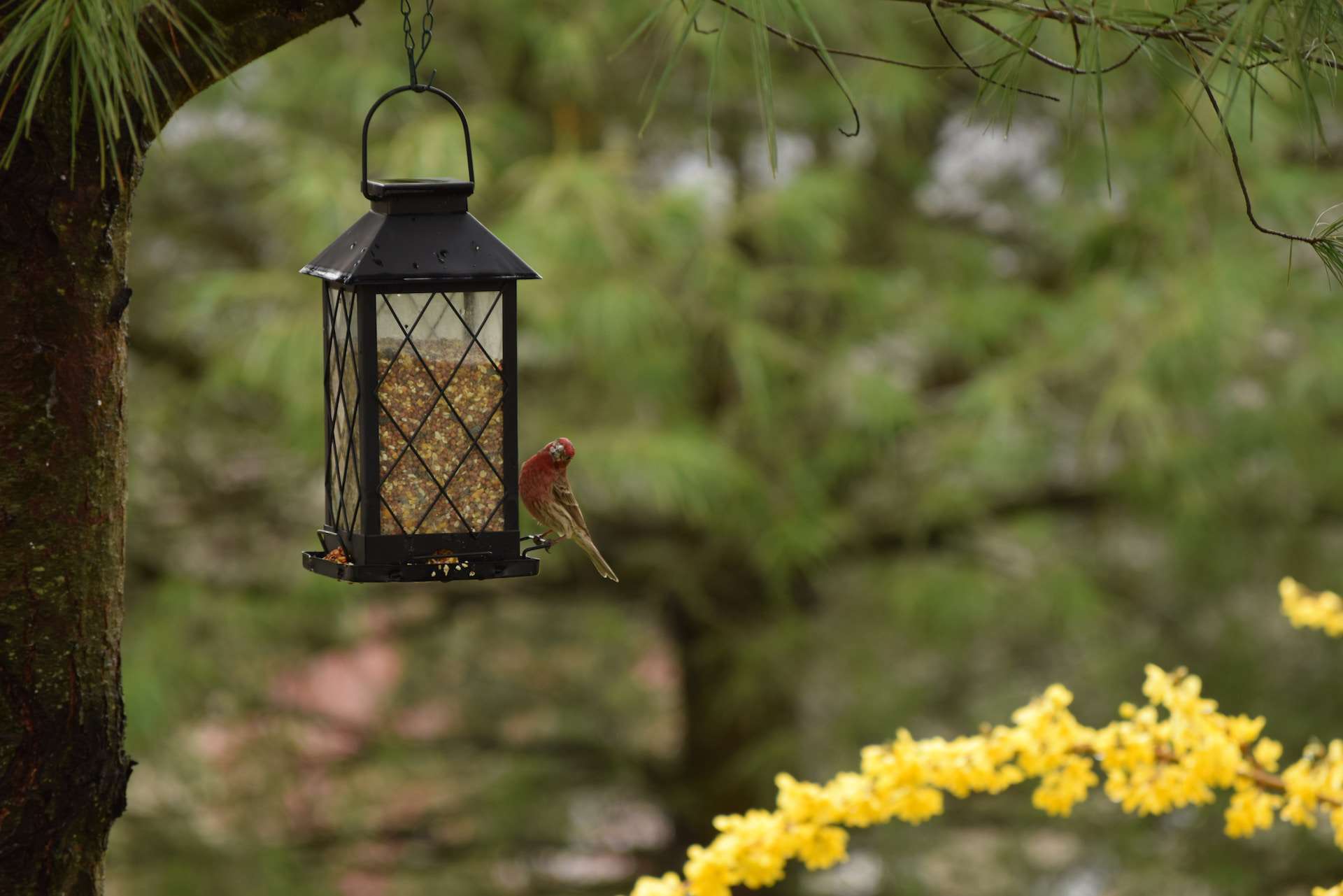
The Blue Jay is a sight to behold and a delight to attract to your backyard. However, these beautiful birds can be selective about their feeding habits.
To help you create an inviting space for them, we’ve compiled a list of the top five bird feeders that are specifically designed to cater to Blue Jays. These feeders have been chosen based on their design, ease of use, and popularity among bird lovers.
Let’s take a look at these options and find the perfect one to make your backyard a Blue Jay paradise.
1. Woodlink Tray Feeder
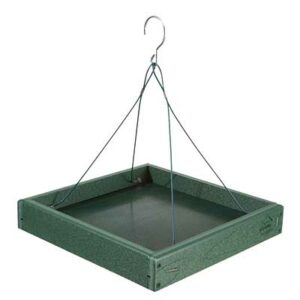
The Woodlink Tray Feeder stands out for its simplistic yet effective design. This open feeder mimics the natural feeding habits of Blue Jays, making it a top choice among enthusiasts.
Crafted with durability in mind, the Woodlink Tray Feeder is made from high-quality materials that can withstand the elements year after year. Its sturdy construction ensures it remains in pristine condition, providing a reliable feeding station for Blue Jays throughout all seasons.
In addition to its durability, this feeder boasts a thoughtful design that caters specifically to Blue Jays’ feeding preferences. The open tray design makes accessing the seeds easy for these vibrant birds, and the raised edges prevent any spillage. This means less wasted food and more enjoyment for the Blue Jays that frequent your yard.
What We Like
- Simplicity: The Woodlink Tray Feeder’s straightforward design makes it easy to use and clean.
- Open Design: This feature allows Blue Jays to easily access food, promoting natural feeding habits.
- Visibility: The open tray provides a clear view of the birds, enhancing the birdwatching experience.
What We Don’t Like
- Frequent Cleaning: The open nature of the tray means it can get dirty quickly, requiring regular cleaning.
- Attracts Other Wildlife: The feeder’s design and accessibility may attract squirrels and other birds, leading to faster food depletion.
- Weather Exposure: The food can be exposed to weather elements like rain or snow, which might spoil it.
2. Droll Yankees Platform Feeder
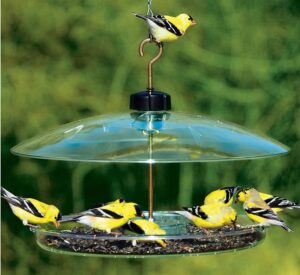
The Droll Yankees Platform Feeder is an excellent choice for attracting various bird species, including Blue Jays. This feeder stands out for its adjustable dome feature and large feeding platform.
One notable feature of the Droll Yankees Feeder is its ability to accommodate different types of food. Blue Jays are known to enjoy a variety of seeds, nuts, and grains, and this feeder allows you to offer a diverse menu to cater to their preferences.
In addition to its durability, this feeder boasts a thoughtful design that caters specifically to Blue Jays’ feeding preferences. The open tray design makes accessing the seeds easy for these vibrant birds, and the raised edges prevent any spillage. This means less wasted food and more enjoyment for the Blue Jays that frequent your yard.
Additionally, the Droll Yankees Feeder includes a built-in rain guard. This feature ensures that the seeds stay dry and do not spoil, guaranteeing that the Blue Jays always have access to fresh and nutritious food.
What We Like
- Adjustable Dome: This feature allows you to control the size of birds accessing the feeder. It also protects the food from weather conditions, ensuring it remains fresh for longer.
- Large Platform: The sizable tray allows multiple birds to feed at once, promoting diversity in your backyard.
- Drainage Holes: These prevent water from pooling in the tray and spoiling the food.
What We Don’t Like
- Size: The large size might not suit smaller yards or balconies.
- Frequent Refilling: Depending on the number of birds attracted, this feeder may require frequent refills.
- Potential for Mess: The open design could lead to an accumulation of bird droppings and discarded seeds around the feeding area, requiring regular cleaning.
3. Kingsyard Hanging Tray Bird Feeder
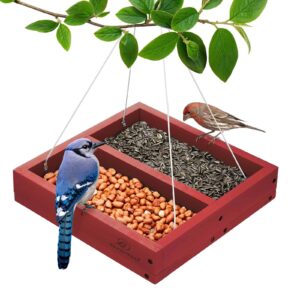
The Kingsyard Hanging Tray Bird Feeder is a great option for attracting avian visitors, including Blue Jays. Its design and features cater well to the needs of these birds.
The tray design of the Kingsyard Hanging Feeder provides a spacious and open feeding area, perfect for accommodating multiple Blue Jays at once. It allows the birds to perch comfortably and enjoy their feast, promoting a sense of tranquility and delight in the surrounding environment.
Crafted from durable materials, this feeder is built to withstand various weather conditions, ensuring its longevity and durability. It will remain in pristine condition for years to come, serving as a reliable and sturdy feeding station for Blue Jays.
The tray design of the Kingsyard Hanging Tray Bird Feeder makes it effortless for Blue Jays to access the food. This design feature ensures that the Blue Jays can have a mess-free eating experience every time they visit.
What We Like
- Adjustable Design: The ability to adjust the height allows you to control the size of birds visiting the feeder.
- Durable Construction: Made from rust-proof metal, this feeder is sturdy and can endure various weather conditions.
- Hanging Tray: This feature provides ample space for birds to feed and also provides a deterrent for squirrels.
What We Don’t Like
- Complex Adjustments: Some users might find adjusting the feeder’s height a bit complicated.
- Frequent Refills: Depending on the number of birds attracted, this feeder may require regular refilling.
- Potential for Spillage: The swinging motion of the hanging tray might result in food spillage.
4. Solution4patio Usa Cedar Tail Prop Suet Bird Feeder
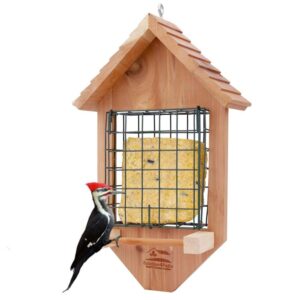
The Solution4Patio USA Cedar Tail Prop Suet Bird Feeder is an excellent choice for attracting woodpeckers and other large birds. This feeder has a unique design and features that cater to these birds.
One of the standout features of the Solution4Patio USA Cedar Tail Prop Suet Bird Feeder is its tail prop design. This innovative feature allows Blue Jays to comfortably perch on the feeder and prop their tails while they eat. This provides a natural and comfortable feeding position for the birds and adds an extra level of stability to the feeder, reducing the risk of it tipping over.
In addition to the tail prop design, the Solution4Patio USA Cedar Tail Prop Suet Bird Feeder is made from high-quality cedar wood. Known for its durability and natural resistance to weathering, cedar wood ensures that the feeder will withstand various weather conditions and remain in excellent condition for a long time. This makes it a reliable feeding station for Blue Jays throughout the year.
What We Like
- Tail Prop Design: This unique feature caters to birds with long tails, allowing them to balance while feeding.
- Suet Cage: Integrated into the feeder, this cage is ideal for holding suet cakes, attracting various bird species.
- Cedar Construction: The sturdy and durable USA cedar construction has a natural aroma that can attract birds.
What We Don’t Like
- Limited Variety: The specific design may not attract many bird species.
- Frequent Refills: Depending on the number of visiting birds, the suet cake holder might require regular refilling.
- Maintenance: Cedarwood, while durable, may require some maintenance to keep it in good condition.
5. Peanut Wreath
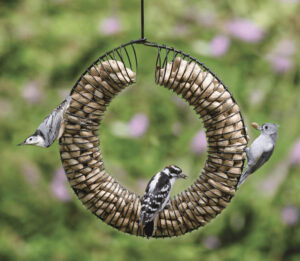
The Peanut Wreath is a unique bird feeder that caters to nut-loving birds. As the name suggests, this feeder is shaped like a wreath and is meant to be filled with whole peanuts, a favorite treat for many birds.
The Peanut Wreath not only offers nourishment for peanut-lover birds, but it also adds a decorative touch to your garden or backyard. Its circular design and mesh structure allow multiple birds to feed simultaneously while providing an entertaining display of their feeding antics.
What We Like
- Mesh Design: The design encourages birds to stay longer as they work to extract the peanuts, providing more bird-watching opportunities.
- Versatile Feeding Option: This feeder can hold whole peanuts, which attract a variety of bird species.
- Squirrel Deterrent: Peanuts in the shell can deter squirrels, ensuring the birds benefit from the feeder.
What We Don’t Like
- Difficult to Clean: The mesh design may be challenging to clean thoroughly.
- Frequent Refills: Depending on the number and type of birds attracted, this feeder might require regular refilling.
- Potential for Mess: Discarded shells can create a mess around the feeding area, requiring regular cleanup.
Things to Look For Before Buying the Right Blue Jay Feeder
When purchasing a bird feeder, several factors must be considered to ensure you choose the best one for your needs. Let’s take a look at some of them:
Understanding The Blue Jay’s Dietary Needs
Blue Jays are omnivorous birds, meaning they eat various foods depending on what’s available. Understanding their dietary needs can help you attract these colorful birds to your yard.
- Seeds and Nuts: Blue Jays strongly prefer sunflower seeds, peanuts, and acorns. They have a unique ability to crack open shells with their beaks to access the nutritious insides.
- Fruit: Blue Jays also enjoy a variety of fruits, including berries, cherries, and small apples. Providing a bird feeder that can accommodate fruit can attract these birds to your yard.
- Insects and Small Animals: Besides plant-based foods, Blue Jays eat insects and small animals like spiders, snails, and even small rodents or baby birds. However, this is less common and typically occurs when other food sources are scarce.
- Suet: Suet, a type of animal fat, is another food source for Blue Jays, particularly in the winter months when other food sources might be less available. Suet can provide essential energy and nutrients during this challenging season.
- Grains: Blue Jays can eat corn, wheat, and other grains, but these should be a smaller part of their diet than nuts and seeds.
Feeder Material
The material of a bird feeder can greatly impact its durability, maintenance, and the types of birds it attracts. Here are some common materials used in bird feeders:
- Wood: Wooden bird feeders, like cedar or pine, are popular because of their natural look that blends well with outdoor environments. They’re durable but require regular maintenance to prevent rotting or damage from the elements.
- Metal: Metal bird feeders are durable and often come with squirrel-proof designs. They are resistant to weather and are easy to clean, but they may not provide as much visual appeal as other materials.
- Plastic: Plastic bird feeders are lightweight and affordable. They are also easy to clean. However, they might not be as durable as wood or metal feeders, especially in areas with harsh weather conditions or aggressive squirrels.
- Ceramic or Clay: These materials can be used to make beautifully designed bird feeders. While they can be more fragile than wood or metal, they offer a unique aesthetic appeal.
- Recycled Materials: Some bird feeders are made from recycled materials, providing an eco-friendly option. They can be just as durable and functional as feeders made from new materials.
Capacity
The capacity of a bird feeder refers to the amount of bird food it can hold at any given time. This is a crucial factor to consider because it affects how often you’ll need to refill the feeder and how many birds it can accommodate simultaneously.
- Small Capacity Feeders: These feeders typically hold less than two pounds of bird seed. They’re ideal for small gardens or balconies where there are fewer birds. The advantage of smaller feeders is that they ensure bird food is consumed while it’s still fresh and hasn’t been exposed to the elements for too long.
- Medium Capacity Feeders: These feeders can hold between two to five pounds of bird seed. They’re suitable for most suburban gardens and can cater to a moderate number of birds without requiring daily refilling.
- Large Capacity Feeders: These feeders can hold more than five pounds of bird seed. They’re ideal for large yards or gardens in rural areas with many birds. The main advantage is that they don’t require frequent refilling, but it’s important to ensure the food stays dry and fresh to prevent spoilage.
Ease of Cleaning
Ease of cleaning is a crucial factor to consider when choosing a bird feeder. Regular cleaning prevents the spread of diseases among birds and keeps the feeder attractive to them.
- Removable Parts: Bird feeders with removable parts are often easier to clean. You can take them apart and clean each piece individually, ensuring no spots are missed.
- Material: The material of the feeder can affect its ease of cleaning. Plastic and metal feeders can generally be cleaned easily with soap and water, while wooden feeders may require more care to avoid damaging the wood.
- Design: Some designs are inherently easier to clean than others. For example, tube feeders can be difficult to clean inside without a removable top or bottom. Tray or platform feeders are typically easier to clean because they have an open design.
- Size: The size of the feeder can also impact how easy it is to clean. Larger feeders may be more difficult to handle and require more cleaning time.
Price
The price of bird feeders can vary widely based on several factors, including the materials used, the size of the feeder, its design complexity, and the brand. Here’s a general breakdown:
- Budget-Friendly Feeders ($10 – $30): These are typically smaller, simpler models made from plastic or inexpensive metal. They may not have many extra features, but they can still effectively attract birds to your yard.
- Mid-Range Feeders ($30 – $100): These feeders might be larger, made from more durable materials like high-quality metal or wood, and have additional features like squirrel-proof designs or intricate decorative elements.
- High-End Feeders ($100 and up): These feeders are usually premium models made from top-tier materials, like copper or recycled composite material. They often come with advanced features, such as auto-refill mechanisms, sophisticated squirrel deterrent systems, or artistic designs that enhance the aesthetic appeal of your garden.
Conclusion
Selecting the best Blue Jay feeder is a careful balance of multiple factors. Understanding the dietary habits of Blue Jays is the starting point, followed by considering the feeder’s material, capacity, ease of cleaning, and budget.
While there are many options available in the market, the best feeder for you will effectively cater to the needs of the Blue Jays while fitting seamlessly into your lifestyle and garden aesthetics. Remember, attracting these beautiful birds is not just about providing food but also creating a safe and clean environment for them to thrive.

